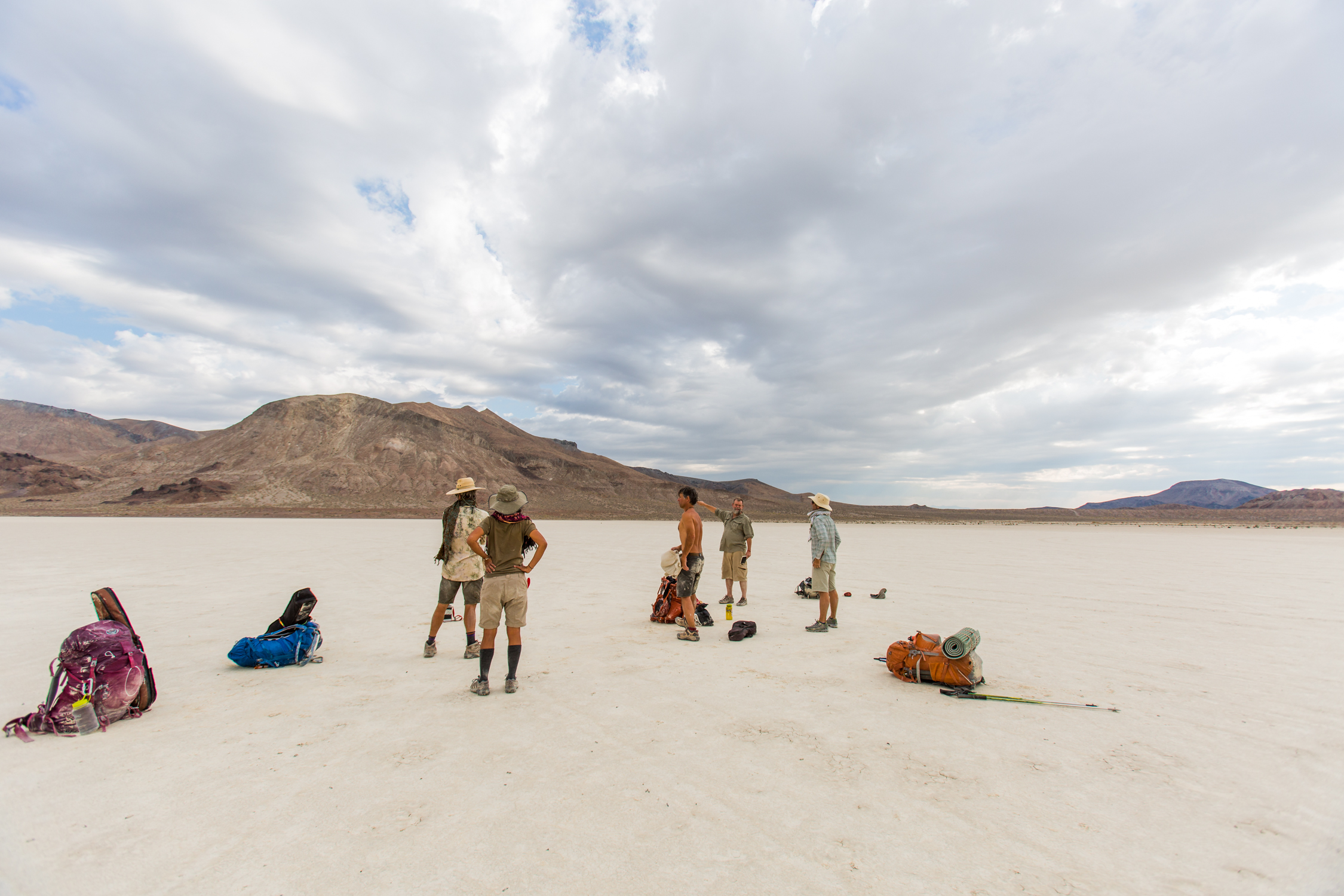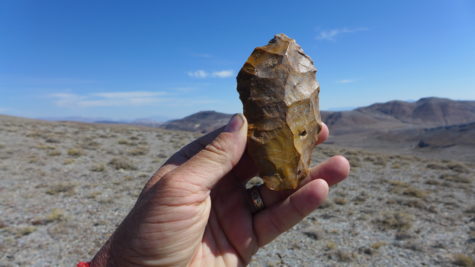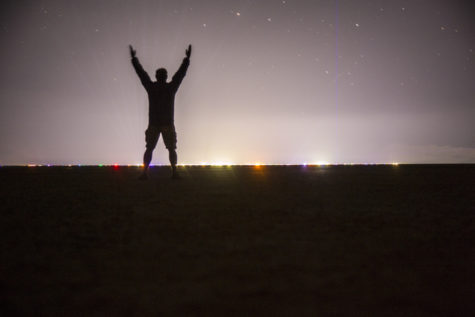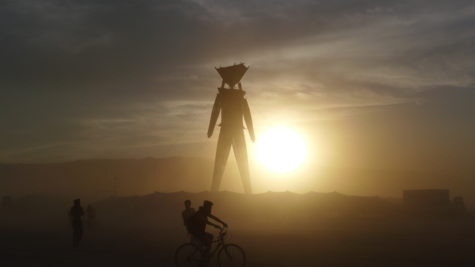In the summer of 2014 I backpacked across the Black Rock Desert to Burning Man with a small group of friends, after which this piece was originally published. It has been only slightly altered. Since the lake bed is from late Pleistocene origin, and the loud and luminous eruption of this annual event will be starting up again soon, re-posting anytime in a several-thousand year bracket works. Today is the day.

I’ve just returned from Burning Man, a Mad Max bacchanalia in the desert of western Nevada. I went to see what civilization was up to, what fiery pinnacle we’ve invited into this empty space. I also wanted to see the event in context of deep time, which is why my journey to this conflagration of 70,000 people did not begin in a miles-long train of dusty, sun-baked cars and RVs waiting to get in, but farther out in the desert, on foot.
Since I first heard of Burning Man, the way I imagined getting there was by walking, coming in from the horizon like a mirage. In 2014 (my first and so far only expedition to the gathering), I began with a crew of six in a barren-rock mountain range several days north of the site. We wound our way south toward an increasing glow on the horizon where you’d normally see only darkness at night.
My intention was not to follow a straight line, but to weave in and out of the terraced shorelines of an ancient lake that once filled this desert basin. Lake Lahontan peaked around 11,000 years ago as glaciers melted into the end of the Ice Age, leaving most of northwest Nevada underwater. We used its desiccated beaches and playa-edges as our route, following a Pleistocene route to the event.I took this route to put the spectacle of Burning Man into perspective. During the cold, arid Younger Dryas climate-anomaly that struck the Northern Hemisphere around 12,000 years ago, the Great Basin became a well-watered oddity. This was one of the best places to live on the continent, and people left countless stone tools and flakes along ancient lakeshores that now stand barren and windswept. As we walked ridges above what had been one of the largest freshwater bodies on the continent, we found work stations where people had sat flaking butterscotch-colored rock. Among hundreds upon hundreds of sharp slivered stones were actual worked pieces, elegant preforms ready for transport, where they would have been later made into spear points or scrapers. Picking them up, holding them to the sky, we could see the action of hands long before our own.

Seeing this much human activity stood in stark contrast to the desolation around us. We’d seen some lizards and spiny little shadscale bushes, and not much else. Nothing here now but these stones spoke to the richness that was here before.
During the summers of 1981 and 1982, the complete skeleton of one of largest mammoths found on this hemisphere was excavated from the foot of one of these mountains. Thirteen feet tall at the shoulder, it was found beneath blowing dunes a short distance onto the playa, probably where it fell on a beach that no longer exists. Three ribs show healed fractures of an older animal, big mammoth bull at the edge of the lake.
A single milk tooth of a young saber-tooth cat turned up in the excavation, offering a sketch of what might have happened there. Not only were adult cats on the carcasses, but the young were coming in for a blood-muzzled meal. The excavation also revealed 32 stone tools nested around the mammoth bones, giving greater definition to this animal’s demise. If they’d been scavengers, people may have had to run saber-tooths off the carcass, hooting and hollering, or charging with spears and barking dogs while the big cats snarled and swept their ten-pound paws in the air before reluctantly loping away. Or it happen the other way, the balance still tenuous between hunter and hunted 11,000 years ago. The cats could have taken it from the people. One irritated cat charges, taking advantage of a gap, a moment of hesitation, and it strikes like an African lion: claws first, then the grip of forearms, and a quarter second later the lash of teeth and flaring neck muscles, spear shaft shattering as the life of a skin-clad man or woman ended.
The mammoth fell on a beach and was soon covered by pulses of glacier melt as the lake rose, preserving its bones deep in anaerobic, waterlogged muck that has now turned to dust.
How would you know these stories were ever here? Excavations and painstaking surveys have drawn legends out of the ground. Attendants at Burning Man exclaim that they have come to an empty place, a void on which to witness one of the biggest parties on earth, but how much richer the story becomes when you know what is in the ground beneath you.

Each night, the light of Burning Man glowed brighter as spotlights began sweeping the sky. Seven miles north of the site we watched volleys of flame shoot out of the spread of colored lights. Even this far away, lasers struck our bodies. It was hard to tell if we were drawn toward it or repulsed. The silence of the desert lay behind us, while ahead rose a lake of light and sound.
On the final morning of our walk, under the lone shade of our umbrellas we strode toward a wall of sound, an arrhythmic, thumping soundtrack of sunrise DJs. We entered from the silent desert and its retired histories to the riveting buzz of here and now. You no longer had to stretch your senses to the point of imagination. By that afternoon, we were in the thick of nakedness and fur-lined costumery. Winds and playa dust howled around enormous art installations. No hour of day or night was any quieter, as primal, competing drumbeats drilled your skull to the point of ecstatic madness. Five nights later, the great wooden man at the center of the site burned to the roar of tens of thousands of celebrants. Fireworks and plumes of flame swelled into the sky as I imagined us at the bottom of a lake, all of us hundreds of feet underwater.

Image by James Q Martin and Craig Childs
I think you have cured me of a longing to go to Burning Man. What once seemed an exciting variable star, a sort of 20th century rendezvous of “art” and theater, now appears to be self indulgent puffery. The silence of deserts, where the only drum is the blood in my ears, is cleaner.